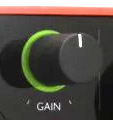I ended up just restoring my system to before I downloaded the Focusrite software
Not a surprise. The device software almost always adds features and extra talents, not the ability to make a basic recording. And, as you found, sometimes in their effort to take over sound management, they may appear to make things worse.
If you dig in your Windows > Control Panels > Sound, do you show Microphone Boost ticked or turned up? My guess when you installed the Solo software it established a sound pathway without the boost and that’s where your sound went.
The ElectroVoice RE-20 is a terrific microphone, but it is, at base, a Dynamic (moving coil) microphone and not known for blistering high volume.
When you use it with the Solo, do you ever get the flashing green volume knob?

I’m guessing no. That’s the Solo’s indication of good volume. I would not be shocked to find you had to turn the solo all the way up to get comfortable recording and the green knob. Do Not select 48V or AIR. Turn the INST volume down.
The Solo knob can also turn red. That’s your indication of volume too high. Try this once. Turn the Solo all the way up and yell into the microphone. Never blow into a microphone or hit one, but you can perform as loud as you want. Can you ever get the red knob? Just before the red knob is the upper end of your volume range. That will give you an idea how quiet your system is working.
Home systems are designed quiet because of a mandate from Marketing. Loud microphones and systems can create distortion and make you want to send them back. Quiet systems make you think sound problems are your fault and keep the microphone.
Meanwhile, back at Windows. Once the Solo is happy, you may find that you no longer need Microphone Boost ticked.
That’s just basic How To Microphone. That has nothing to do with computer popping and ticking noises.
We have never established a common noise problem. A good start on a Windows machine is do a clean shutdown (Shift+Shutdown) and then don’t let anything else start when it comes back up. Then run Audacity.
Audacity hates external drives, network drives, and cloud drives. See if recording on a clean, isolated machine works OK. You can move work off to other drives using Windows, just don’t let Audacity see what you’re doing.
And yes, do post back as you go. Suzy Sunshine will tell you if you continue to have problems recording on the computer, stop recording on the computer. Record on a dedicated Stand-Alone Sound Recorder and transfer sound files back and forth.
The Zoom H5, for one example, supports XLR microphones.
https://www.sweetwater.com/store/detail/H5--zoom-h5-handy-recorder
I have a Zoom H1n and a Zoom H4. There are mechanical considerations, you have to transfer sound files, but suddenly, no computer data noises—or fan noises.
This is Josh’s H6.
He did the whole first part of his music career on an H2.
Koz



